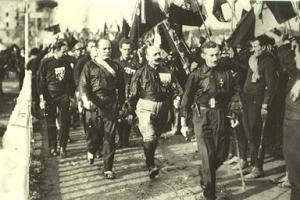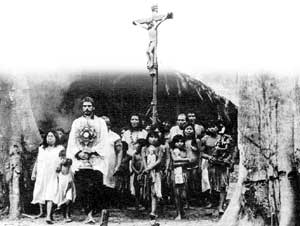The historical period was the 1550s in both Europe and in the Americas. European colonization and warfare had existed within two full continents on the globe, (Europe and the Americas), and Europe’s disease ridden, stench-filled warriors were moving well into African and Asian territories. These madmen from this small continent in the north knew that they were on to something greater than themselves. Somehow, God or the Cosmos itself was involved.
However, the supremacy of the Roman Catholic Church had lost its power in most of northern Europe, the exceptions surviving with Ireland in the west, and the Polish-Lithuanian Empire in the east. The Protestant Reformation was successful. The noxious dream of a great empire of western Christendom was over. The Roman Catholic Papacy had earlier rejoiced in the Turkish sack of Constantinople, renamed Istanbul, and so the Greek Orthodox Church, which still claimed the papal supremacy of Rome, was scattered in the east. Only the Czar of Russia claimed some authority over the defense of Orthodoxy. But he was in the eastern European frontier, and the Mongol Muslim Khanates still had their power bases in central Asia counterbalancing Russia. Out of this geo-political stalemate, which still survives somewhat today, a religious-ideological leader emerged.
There were many prophets and self-proclaimed leaders in those days, (like in our days), but one ideological movement changed world history – and even without military conquests. The religious ideologue was a Basque soldier turned religious mystic, Iñigo de Loyola, and his new religious order, the Jesuits, or the Society of Jesus. This religious order in defense of the Roman Catholic Church was no ordinary order of monks, like the Benedictines or the Carmelites, nor was it simply a preaching order, such as the Franciscans and the Dominicans. These warriors of the Lord obeyed Paul’s principles in his second letter to Timothy, to both live and die as good soldiers in Christ. So, they did everything for the greater glory of God.
They became the confessors to Catholic monarchs, advisers to Catholic princes, opened numerous schools and taught the sons of elites. They occupied the most prestigious posts of scholarship in Catholic universities, wrote endless theology pamphlets, books, histories, poetry compendiums, philosophical treatises, and scientific theses. They directed new forms of painting, sculpture, architecture, theater, music and ritual performance, which history refers to as the Baroque. They even ventured to the extreme parts of the Earth as missionaries to convert the heathens and heretics.
By the turn of the century, the 1600s, they transformed the Roman Catholic Church, which history refers to as the Tridentine Church. Vatican II would officially change this Tridentine Church in the 1960s. They also changed the face of the world. Their doctrines, such as the Good Death practice, and intensive church building, laid the Order’s foundations in most of the capitals of Europe, (the exceptions being the Protestant ones, such as London), and within their colonies, such as Bahia, Brazil, Lima, Peru, Mexico City, Goa, India, Congo, Africa, and Macao, China. Their missions in the interior of Paraguay with the Guarani nation created a successful Christian community of Herbal Matte, or Yerba Mate, commerce, and armed self-defense against Portuguese, mixed race slave raiders, called Paulistas based in the small coastal city of Sao Paolo. The 1600s or seventeenth-century was their century.
By the 1700s, the eighteenth-century, these same staunch Catholic monarchs began to hate them. They were jealous of their power, and conspiracy theories emerged. How did this religious order become so successful, so powerful and so respected, and even their Protestant enemies admired them? Many believed that the Jesuits simply stole and manipulated their willing dupes, wealthy ones mostly, into handing over their loot. Pope Clement XIV suppressed the order in the late eighteenth-century due to pressures from the courts of Catholic monarchs. After the Napoleonic Wars in Europe, around 1815, the Pope lifted the suppression.
The real reason for the ‘power of the Jesuits’ was their practice of the Discernment of Spirits, or more honestly, the Discernment of Ideologies. Loyola advocated this practice incessantly. A good Jesuit had to read enormously and devour the written works of humanity, and even the texts of enemies in order to debate them and counter their propaganda. This Jesuit practice possessed the name of Propaganda Fide, or Propaganda in defense of the Faith. This practice works and it still works. Think on the Anarchist Propaganda of the Word and of the Deed.
Those Christian missionaries were quite hateful and intolerant, but at least they put their words into practice, and most importantly, they were prepared for any contingency because they knew the ideologies of the world during the 1600s: Confucianism, Daoism, Buddhism, Hinduism, Pietism, Puritanism, Mystical Illuminism, Jansenism, Anabaptist-Quakerism, Calvinism, Lutheranism, Manichaeism, Sufism and even Atheism.
Nowadays, there are thousands of more ideologies, whether political, intellectual, religious or philosophical, across the globe. They all share a desire for power and the violent use of power over others. As Anarchists, they are our enemies and we fight them. But first, and like the Jesuits of old, we must also read about them. We do not have to read the entirety of their badly written books, but we can see their emphases, analyze their key words and points that they harp on, and we can possess an overall view of their conniving tactics. Some examples of the more dangerous ideologies of today are American Exceptionalism, Zionism, Communitarianism, Psychobabble, the End of History, Postmodernism, Communalism, Feminist-Puritanism, Christian Evangelical Dominionism, Media Objectivism and Global Neoliberalism.
But we are living in times that are more dangerous because the above nefarious ideologies often disguise their sinister and violent ideals through ‘anti-system’ tactics. Even well read Anarchists have fallen into their traps. We forget that the European Fascist movements of the twenties and thirties started on the streets. Both Mussolini and Hitler were ‘anti-establishment’ figures. Even the Zionists were revolutionary terrorists at one time in their history. As Anarchists, we must remain careful in supporting the first protests, demonstrations, riots, rebellions and revolutions that we watch against a particular State. Some good examples are the actual ‘rebellions’ against regimes in west Asia and in northern Africa.
Is the current rebellion in Turkey, which actually started last May Day, a true spirit of Anarchist rebellion against a corrupt state? May Day in Turkey often has more representation from Communist groups and Kurdish separatists than Turkish Anarchists. The current regime is corrupt like all states, but some of those courageous ‘street revolutionaries’ are also Kemalists, meaning that they support a Fascist platform for Turkish political-cultural supremacy in both the Balkans and in west Asia. Nazi Germany also organized Turkic-Albanian-Bosnian SS divisions during WWII. Also, when disguised fronts for Anglo-American Imperialism and Genocide, such as Amnesty International or Human Rights Watch, condemn the ‘despotic regime’ under duress, then this should make the Anarchist think again about defending all of the street rebels.
We can add the racist murderers and revolutionaries in Libya supported by the US, Britain and France, or the Wahhabi-Salafist religious extremists and murderers of Christians and Shiites, supported by the US, Britain, France, Turkey, Qatar and Saudi Arabia in Syria. These fighters are in rebellion against a corrupt, dictatorial State, yet whose side are those fighters truly on? As Anarchists, we ought to look upon our sick and evil world the same way our state enemies look at it, and the same way the Jesuit Order looked upon it during the 1600s.
The Discernment of Ideologies then comes into full practice. We see the corporate media announce the street rebellion on ‘the news,’ and soon, the Leftist alternative media plays with the campaign. Yet, we also know that the Leftists are often the willing idiots of the state institutions. They want reforms; Anarchists, on the other hand, want true revolutionary change. The Anarchist has to make a choice: join the revolutionary practice or sit and wait. If we join, we might have to make temporary alliances with our mortal enemies, the Communist gangs, (like in Spain 1936), support the revolt in propaganda writing, (such as Indymedia), or we can act separately against a few open targets of power through hit and run, partisan-guerrilla tactics.
I would choose the latter. In world history, no matter who wins the recall, the resignation or the ‘reelection,’ the regular people always lose. Read between the media lines first, and then decide. Discern the different ideologies on the street first, and then act with force, or disengage for a later date. Once the Anarchist masters the Discernment of Ideologies, he or she becomes greatly more powerful. No state system or self-proclaimed leader can control such a revolutionary. The Jesuits always had the institutional support of the papacy throughout their reign of power. The Anarchist rather, stands alone, or works within small cells, ready with his or her weapon of choice.






